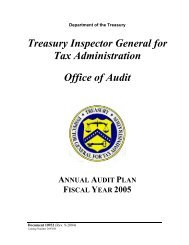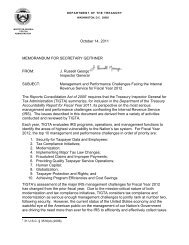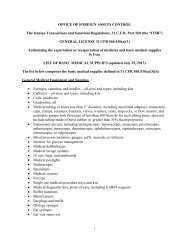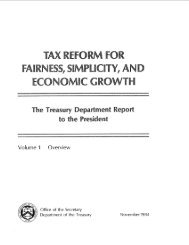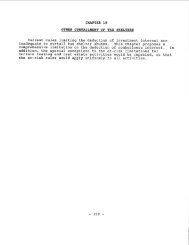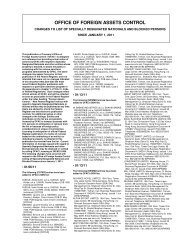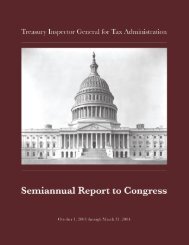PDF - Department of the Treasury
PDF - Department of the Treasury
PDF - Department of the Treasury
Create successful ePaper yourself
Turn your PDF publications into a flip-book with our unique Google optimized e-Paper software.
Strategy to evaluate <strong>the</strong> extent <strong>of</strong><br />
underreporting by employers. IRS<br />
management agreed with <strong>the</strong><br />
recommendation and is taking steps to<br />
evaluate <strong>the</strong> extent <strong>of</strong> <strong>the</strong> problem.<br />
Report Reference No. 2005-30-126<br />
The IRS has not used State tax amnesty<br />
information as an ongoing tool to help<br />
ensure compliance with Federal tax laws.<br />
As a result, it is missing a unique<br />
opportunity to address noncompliant<br />
taxpayers who have acknowledged <strong>the</strong>ir<br />
noncompliance with tax laws to State<br />
governments and who also may owe<br />
Federal taxes. Although an IRS study<br />
included considerable analysis <strong>of</strong> tax<br />
amnesty data for individual taxpayers from<br />
two states, it did not fully explore <strong>the</strong><br />
benefits <strong>of</strong> this information and its<br />
usefulness in IRS compliance programs.<br />
Tax amnesty programs are designed to<br />
collect taxes owed from prior years and<br />
place those who previously avoided<br />
taxation on <strong>the</strong> tax rolls. Over <strong>the</strong> past<br />
23 years, at least 41 states and two cities<br />
have collected more than $5.7 billion from<br />
tax amnesty programs. To encourage<br />
taxpayers to participate, <strong>the</strong>se programs<br />
generally forgave all civil and criminal<br />
penalties. However, <strong>the</strong>y differed as to<br />
whe<strong>the</strong>r all or a portion <strong>of</strong> <strong>the</strong> interest<br />
was forgiven.<br />
TIGTA recommended that <strong>the</strong> IRS evaluate<br />
current Federal and State exchange<br />
programs to determine whe<strong>the</strong>r State tax<br />
amnesty information could be obtained and,<br />
if so, how this data could be used in IRS<br />
compliance programs. IRS management<br />
agreed with <strong>the</strong> recommendations and<br />
proposed corrective action.<br />
Report Reference No. 2005-30-165<br />
The IRS estimates it will achieve<br />
approximately $1.17 billion in additional<br />
revenues if additional funding for its<br />
proposed FY 2006 enforcement initiatives<br />
is approved. This would equate to a<br />
4.4 to 1 return on <strong>the</strong> additional investment<br />
when <strong>the</strong> employees become fully<br />
productive in FY 2008. IRS <strong>of</strong>ficials<br />
believe <strong>the</strong> 4.4 to 1 return on investment is<br />
a conservative estimate, but TIGTA’s<br />
analysis indicates <strong>the</strong> estimate may be too<br />
high. IRS revenue projections were based<br />
on historical averages that weighted data<br />
equally from years when IRS priorities and<br />
technology were substantially different than<br />
in recent years. In addition, business units<br />
did not always provide specific information<br />
to correlate revenue projections to <strong>the</strong> goals<br />
<strong>of</strong> <strong>the</strong> initiatives.<br />
Fur<strong>the</strong>rmore, <strong>the</strong> IRS currently does not<br />
have a methodology to measure revenue<br />
resulting from any adopted initiatives, such<br />
as <strong>the</strong> results <strong>of</strong> increased investment in<br />
enforcement activities. The absence <strong>of</strong><br />
such a measurement limits <strong>the</strong> IRS’<br />
estimating ability to assist in budgeting and<br />
resource allocation.<br />
TIGTA recommended that <strong>the</strong> business<br />
units provide more information on <strong>the</strong> type<br />
<strong>of</strong> work expected to be completed by <strong>the</strong><br />
additional staff to allow <strong>the</strong> IRS to more<br />
accurately project revenues. Additionally,<br />
<strong>the</strong> IRS should consider using a forecasting<br />
model that assigns greater weight to more<br />
recent years’ data, such as exponential<br />
smoothing, when appropriate. The IRS<br />
should also develop a methodology to<br />
evaluate <strong>the</strong> results <strong>of</strong> increased<br />
investments in enforcement activities.<br />
April 1, 2005 to September 30, 2005 11





